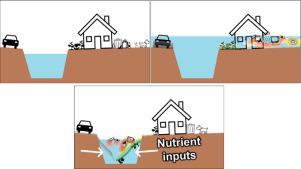Water Research ( IF 12.8 ) Pub Date : 2021-06-04 , DOI: 10.1016/j.watres.2021.117329 Alfonso Macías-Tapia 1 , Margaret R Mulholland 1 , Corday R Selden 1 , J Derek Loftis 2 , Peter W Bernhardt 1

|
Sea level rise has increased the frequency of tidal flooding even without accompanying precipitation in many coastal areas worldwide. As the tide rises, inundates the landscape, and then recedes, it can transport organic and inorganic matter between terrestrial systems and adjacent aquatic environments. However, the chemical and biological effects of tidal flooding on urban estuarine systems remain poorly constrained. Here, we provide the first extensive quantification of floodwater nutrient concentrations during a tidal flooding event and estimate the nitrogen (N) loading to the Lafayette River, an urban tidal sub-tributary of the lower Chesapeake Bay (USA). To enable the scale of synoptic sampling necessary to accomplish this, we trained citizen-scientist volunteers to collect 190 flood water samples during a perigean spring tide to measure total dissolved N (TDN), dissolved inorganic N (DIN) and phosphate concentrations, and Enterococcus abundance from the retreating ebb tide while using a phone application to measure the extent of tidal inundation. Almost 95% of Enterococcus results had concentrations that exceeded the standard established for recreational waters (104 MPN 100 mL−1). Floodwater dissolved nutrient concentrations were higher than concentrations measured in natural estuarine waters, suggesting floodwater as a source of dissolved nutrients to the estuary. However, only DIN concentrations were statistically higher in floodwater samples than in the estuary. Using a hydrodynamic model to calculate the volume of water inundating the landscape, and the differences between the median DIN concentrations in floodwaters and the estuary, we estimate that 1,145 kg of DIN entered the Lafayette River during this single, blue sky, tidal flooding event. This amount exceeds the annual N load allocation for overland flow established by federal regulations for this segment of the Chesapeake Bay by 30%. Because tidal flooding is projected to increase in the future as sea levels continue to rise, it is crucial we quantify nutrient loading from tidal flooding in order to set realistic water quality restoration targets for tidally influenced water bodies.
中文翻译:

潮汐洪水对河口生物地球化学的影响:量化城市、切萨皮克湾下游支流中洪水驱动的氮输入
即使在全球许多沿海地区没有伴随降水,海平面上升也增加了潮汐洪水的频率。随着潮汐上升,淹没景观,然后退去,它可以在陆地系统和邻近的水生环境之间运输有机和无机物质。然而,潮汐洪水对城市河口系统的化学和生物影响仍然很有限。在这里,我们提供了潮汐洪水事件期间洪水营养物浓度的首次广泛量化,并估计了拉斐特河(美国切萨皮克湾下游城市潮汐支流)的氮 (N) 负荷。为了实现实现这一目标所需的天气采样规模,退潮后的肠球菌丰度,同时使用手机应用程序测量潮汐淹没的程度。几乎 95% 的肠球菌 结果的浓度超过了为娱乐用水制定的标准 (104 MPN 100 mL -1)。洪水溶解养分浓度高于自然河口水中测得的浓度,表明洪水是河口溶解养分的来源。然而,只有洪水样本中的 DIN 浓度在统计上高于河口。使用流体动力学模型计算淹没景观的水量,以及洪水和河口中 DIN 浓度中值之间的差异,我们估计在这一单一的蓝天潮汐洪水事件中,有 1,145 公斤 DIN 进入拉斐特河。这一数额超过了联邦法规为切萨皮克湾这一部分制定的地表流年氮负荷分配的 30%。因为随着海平面继续上升,预计未来潮汐洪水会增加,



























 京公网安备 11010802027423号
京公网安备 11010802027423号